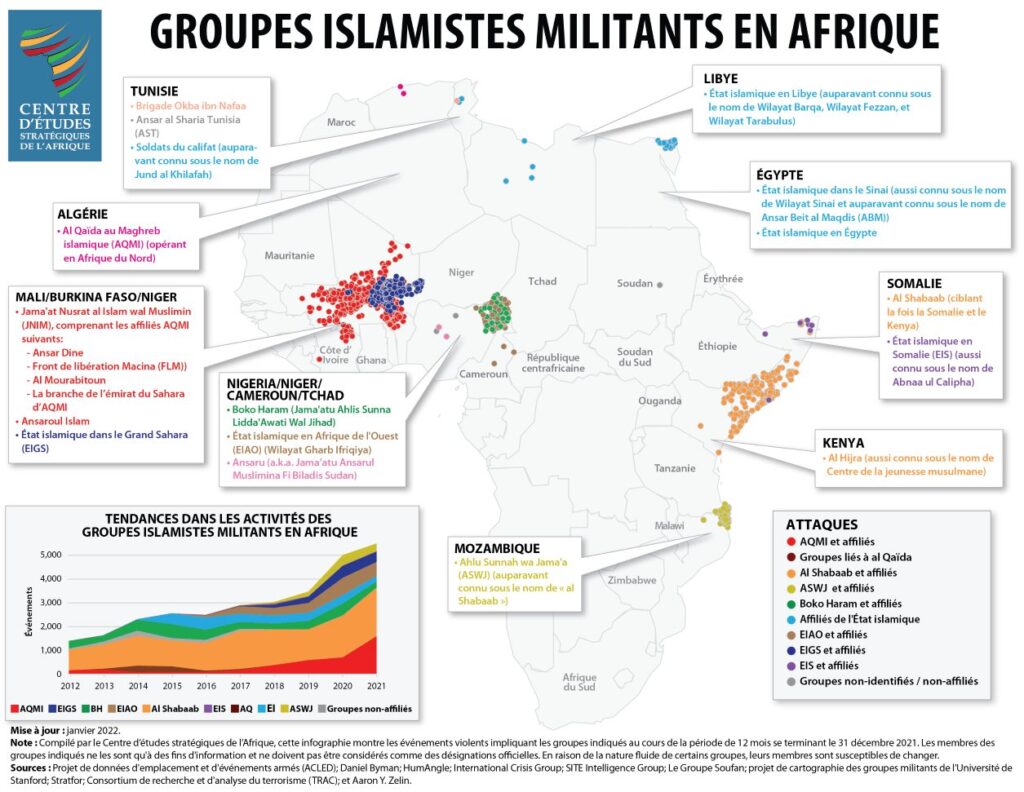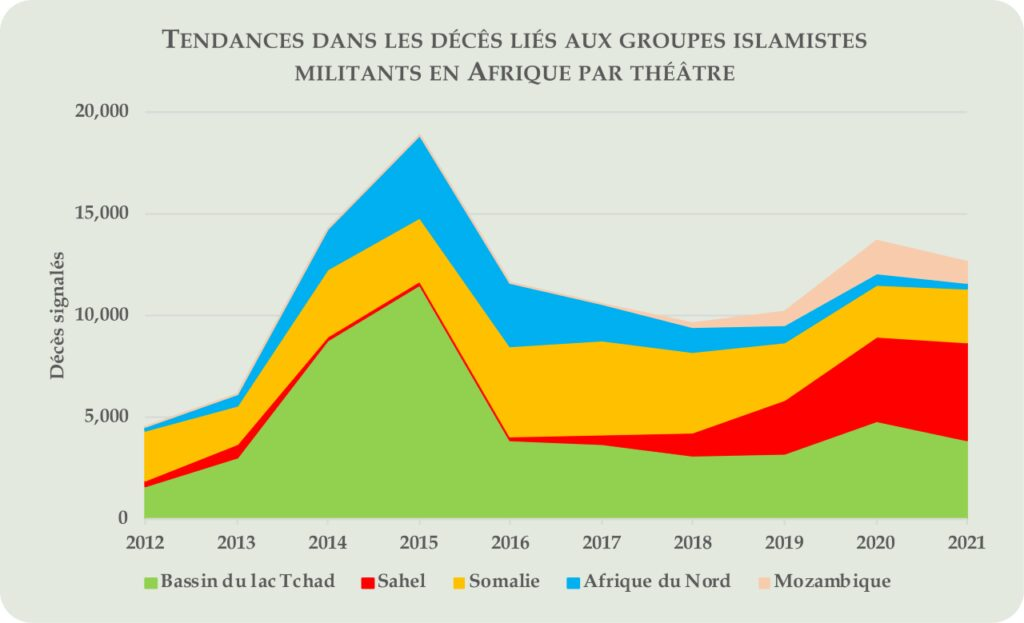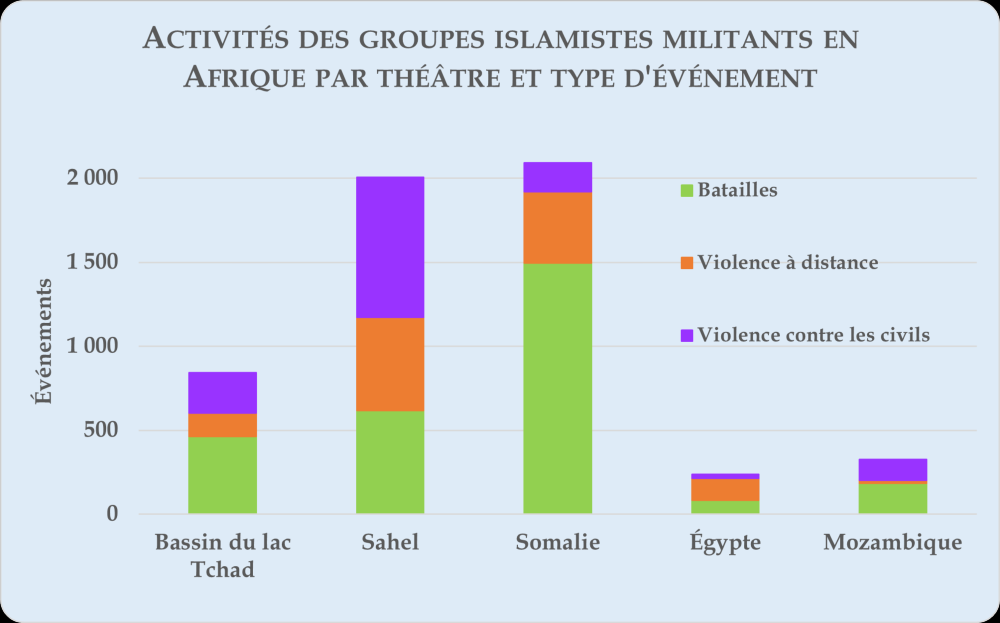In 2021, Africa suffered a new record level of Islamist violence, driven by a 70% increase in violence linked to militant Islamist groups in the Sahel.
Strengths

- The almost doubling of violence linked to militant Islamist groups in the Sahel (from 1,180 to 2,005 events) highlights the rapid escalation of the security threat in the region. This peak is the most important change among all regions prone to violence by militant Islamist groups in Africa. It eclipses a 30% reduction in violence in the Lake Chad Basin, northern Mozambique and North Africa.
- Overall, violence related to militant Islamist groups increased by 10% in 2021, reaching a record level of over 5,500 events attributed to these groups in Africa. This has continued an upward trend since 2016. However, the annual rate of increase was, in 2021, much lower than the 43% increase reported in 2020.
- The number of deaths attributed to militant Islamist groups fell by 7% in 2021 compared to 2020, reaching around 12,700 deaths across Africa. This includes a 14 per cent decrease in deaths attributed to violence against civilians and a decrease in all regions outside the Sahel.
- Battles between militant Islamist groups and military forces or non-state armed groups constitute 52 per cent of the violent events counted in 2021. In recent years, this reflects the continuation of a significant increase in the number of battles in northern Mozambique, Somalia and the Sahel.
- The violence of militant Islamist groups remains largely concentrated in five theatres – Somalia, the Lake Chad Basin, Mozambique, and North Africa – each including separate local actors and particular challenges.

The Sahel
- The 2005 violent events observed in 2021 in the Sahel (notably in Burkina Faso, Mali and western Niger) represent a 70% increase over 2020. The upward trend in violence involving Islamist militant groups in the region has thus persisted uninterrupted since 2015. While it had originated in Mali, its propensity moved to Burkina Faso, where 58% of the Sahelian events occurred.
- Two groups, the Macina Liberation Front (LWF) and the Islamic State in the Great Sahara (EIGS), are responsible for the majority of these attacks. The LWF is part of a coalition of groups with ties to al Qaeda in the Islamic Maghreb known as Jama’at Nusrat al Islam wal Muslimin (JNIM).
- The number of deaths in the Sahel as a result of these violent events is estimated at 4,838. This represents an increase of 17% over the previous year, during which an increase of 57% was recorded. Today, more deaths attributable to militant Islamist groups have occurred in the Sahel than in any other part of Africa.
- The number of attacks on civilians (833) and related deaths (1,332) has doubled since 2020 in the region. The violence of militant Islamist groups against civilians in the Sahel accounts for 60 per cent of such violence in Africa.
- A clear consequence of the violence in the Sahel is the forced displacement of more than 2.4 million people, including 190,000 refugees and 2.2 million internally displaced persons. Burkina Faso has suffered the majority of this phenomenon, with approximately 1.6 million forcibly displaced persons.
- The battles between security forces and militant Islamist groups have also increased, but with enormous differences between groups. In particular, battles with JNIM groups increased by 50%, while battles with the ISIS decreased by 45%.
Somalia
- Violent activity related to al-Shabaab increased by 17% in 2021, from 1,771 events in 2020 to 2,072. This is a doubling of the 1,080 events recorded in 2015.
- The violent events that took place in Somalia accounted for 38 per cent of the events associated with militant Islamist groups in Africa, a similar level in the Sahel. Despite a steady increase in violence in Somalia over the years, this represents, for events involving al Shabaab, a decline of almost half of the activities of militant Islamist groups in Africa over the past decade. This, however, reflects an increase in violence in other regions, including the Sahel.
- Almost three quarters of the events leaguered at al-Shabaab in 2021 took the form of battles between the group and the security forces. Battles increased by 32 per cent, but attacks on civilians decreased by 27 per cent. To increase its influence, al Shabaab continues to take advantage of the political crises surrounding the postponement of the holding of legislative and presidential elections.

Lake Chad Basin
- The 843 violent events that occurred in the Lake Chad Basin (located at the intersection of four countries: Nigeria, Cameroon, Chad and south-eastern Niger) represent a 32% decrease in the activity of militant Islamist groups compared to the previous year. This reflects a significant turn since the upsurge in 2020, although this figure is even 10% higher than the number of incidents recorded in 2019.
- In 2021, the Lake Chad Basin experienced a 21% decline in the number of deaths attributable to militant Islamist groups. Deaths related to Boko Haram saw the largest decline (46 per cent), while deaths attributable to its branch, the Islamic State in West Africa (ISWA) decreased by only 3%. This reality may be due to the major transition that each group underwent in 2021, not the least of which was the death in May of the long-time Boko Haram leader Abubakar Shekau.
- The violence perpetrated by Boko Haram and ISWA against civilians decreased by 49 per cent in 2020. Similarly, remote violence has also declined, such as bombing and improvised explosive devices (33 per cent) and battles (18 per cent).
- The increase in violence in northwestern Nigeria is largely attributable to gangs of organized criminals rather than militant Islamist groups.
Northern Mozambique
- The number of violent events attributable to militant Islamist groups in Cabo Delgado province in northern Mozambique decreased by 25% in 2021, reaching 329 events, a dramatic fall of 129% compared to 2020.
- For the first time since the insurgency began in 2017, northeastern Mozambique suffered more battles (56%) than civilian violence (38%) in 2021. Attacks on civilians decreased by 58% compared to 2020.
- The 1,067 deaths recorded in 2021, of which 66% are battle-related, are a 33% decrease compared to 2020. Deaths related to violence against civilians have decreased by 60 per cent. These declines are the deployment of Southern African Development Community (SADC) and Rwanda troops.
North Africa
- The 234 violent events involving the Islamic State in North Africa are a continuation of a decline that has begun in these incidents for five years after seeing one of 506 events. Almost all events in 2021 occurred in Egypt (about 95%). The 272 deaths counted represent a decrease of 52 per cent compared to 2020 and are 14 times lower than the 4,000 deaths recorded in 2015.
- A long-standing conflict between the Egyptian army and militant Islamist groups in Sinai is the violence that is taking place in the region. Since 2021, 55 per cent of violent events have been of remote violence, contributing to 45 per cent of the deaths recorded. However, battles account for 35% of events and 45% of deaths counted.
